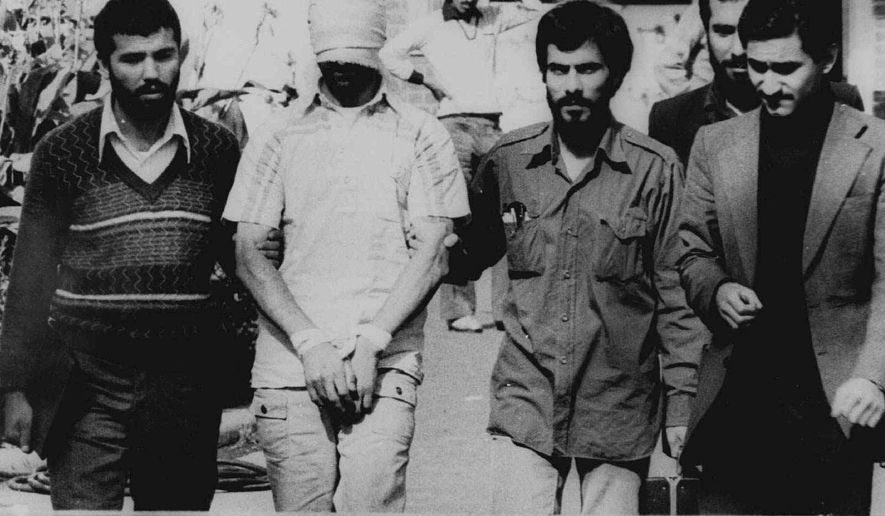DUBAI, United Arab Emirates (AP) - Revolutionaries in the streets give way to black-and-white images of blindfolded American hostages. Two enemies sign a peace deal after years of hostilities. And one of the world’s two superpowers invades its southern neighbor, launching a bloody, decade-long conflict.
These moments and others in 1979, which dominated television sets and newspaper front pages 40 years ago, have shaped the modern Middle East.
Iran’s Islamic Revolution changed a stalwart U.S. ally into a regional adversary. Israel’s accord with Egypt brought a peace that endures today. The Soviet Union’s invasion of Afghanistan began an insurgency in the country that continues even today.
Like the lines drawn in the sand by the British and French after World War I carving up the Ottoman Empire, the events of 1979 also unexpectedly rippled out to affect today’s world.
Perhaps the one moment that still dominates is Iran’s Islamic Revolution. Shah Mohammad Reza Pahlavi, at the time stricken with terminal cancer, left Iran in January 1979. His departure and the revolution the following month brought to an end to 2,500 years of monarchial rule across Persia.
In its place came the Islamic Republic, where absolute power rests with the country’s supreme leader, a Shiite cleric who oversees elected officials and the nation’s military and paramilitary forces. Islam suddenly found itself firmly wedded to a newly formed, modern government.
Though Shiites represent a minority of all Muslims worldwide, the takeover offered inspiration to all Islamic militants. It marked a warning for nations across the Middle East that the threat of leftist militants had given way to religious extremists who said they fought in the name of God against the corrupt.
A band of ultraconservative Saudi Sunni militants in November would seize the Grand Mosque in Mecca, home to the cube-shaped Kaaba that Muslims pray toward five times a day, demanding the Al Saud royal family abdicate. A two-week siege that followed ended with an official death toll of 229 killed. The kingdom’s rulers soon further embraced Wahhabism, an ultraconservative Islamic doctrine.
In losing Iran’s shah, the United States lost its closest ally in the Middle East, one who purchased billions of dollars of American weaponry and allowed spying from his nation on the Soviet Union. America tilted toward Saudi Arabia as the kingdom grew stricter.
Other Mideast nations, nearly all majority Sunni, the main branch of Islam, looked worriedly toward Shiite Iran. In neighboring Iraq, Saddam Hussein orchestrated a televised purge of his Baath Party in July, giving birth to his dictatorship.
Saddam would invade Iran in 1980, starting a bloody eight-year war that killed 1 million people. Dubai’s new Jebel Ali port, the world’s largest man-made harbor that opened in 1979 in the United Arab Emirates, became a safe haven. That increased trade would boost the sheikhdom, which would see other skyscrapers join its lone high-rise that would become the Dubai World Trade Center, also built in 1979.
President Jimmy Carter, whose administration would be continually challenged by Iran throughout the year, found success elsewhere in the Middle East, bringing two longtime foes together. Egypt under President Anwar Sadat became the first Arab country to make peace with Israel.
The deal saw the two nations end a state of war that existed between them since 1948. Israel withdrew from the Sinai Peninsula, which was demilitarized. The countries would exchange ambassadors and establish air routes.
Although the peace deal led to Sadat’s assassination in 1981, the truce opened the door for Jordan to strike its own pact with Israel in 1994. Today, Gulf Arab nations appear closer to acknowledging Israel themselves. Meanwhile, Egyptian President Abdel-Fattah el-Sissi now openly acknowledges that Israel backs Egypt’s campaign against Islamic extremists in Sinai.
Iran again would dominate the news with the Nov. 4, 1979, takeover of the U.S. Embassy in Tehran, sparked by Carter allowing the shah to receive medical treatment in the U.S. For 444 days, Iran held 52 Americans as captives. A few staffers fled and hid in the home of the Canadian ambassador to Iran before escaping the country with the help of the CIA, a story recounted in the 2012 film “Argo.”
American nightly newscasts counted the hostages’ days of captivity. Confusion surrounded the crisis. American officials initially thought Iran could be behind the attack on the Grand Mosque in Mecca, which occurred just after the takeover.
Meanwhile, protesters in Pakistan burned down the U.S. Embassy in Islamabad over rumors America had attacked Mecca. Days later, a mob attacked the U.S. Embassy in Tripoli, Libya.
Carter, a Democrat, ultimately would lose the 1980 U.S. election, held on the first anniversary of the hostage crisis, to Republican Ronald Reagan. The hostages were released minutes after Regan’s inauguration.
Reagan also promised a more muscular U.S. response to the Soviet Union.
The Soviets at the end of 1979 invaded Afghanistan to prop up the deeply unpopular Communist government that had seized power in a bloody coup the year before. They’d occupy the country until 1989 and would face an insurgency of both Afghan and foreign Muslim fighters who viewed the conflict as a holy war, or jihad. The CIA armed the rebels with weaponry, including sophisticated shoulder-fired missiles allowing them to shoot down Soviet helicopters and airplanes.
Among those fighters was a young Saudi from a wealthy family named Osama bin Laden, who years later would create the terror group al-Qaida and mastermind the Sept. 11, 2001, terrorist attacks.
The U.S. would abandon Afghanistan to infighting that would see the rise of the Taliban, whom America went to war with after the 9/11 attack for harboring bin Laden and al-Qaida. That war, the longest in American history, continues today.
___
EDITOR’S NOTE - Jon Gambrell, the acting Gulf news director for The Associated Press, has reported from each of the Gulf Cooperation Council countries, Iran and other locations across the world since joining the AP in 2006. Follow him on Twitter at www.twitter.com/jongambrellap .




Please read our comment policy before commenting.